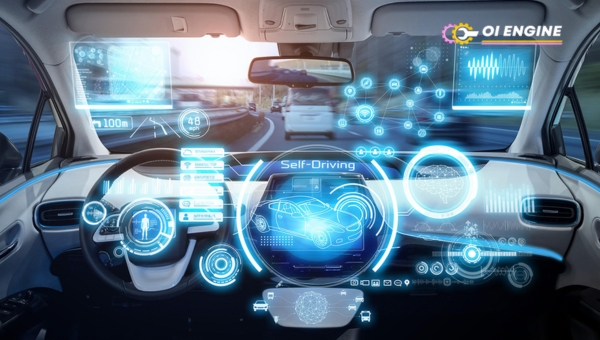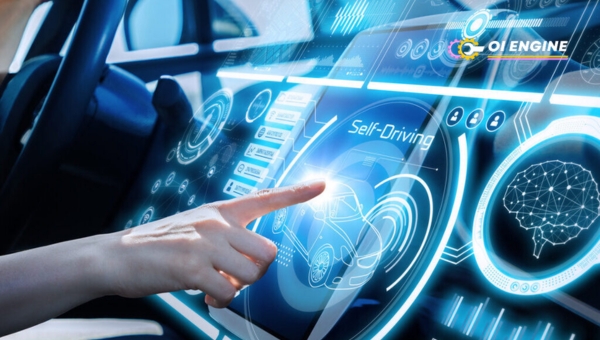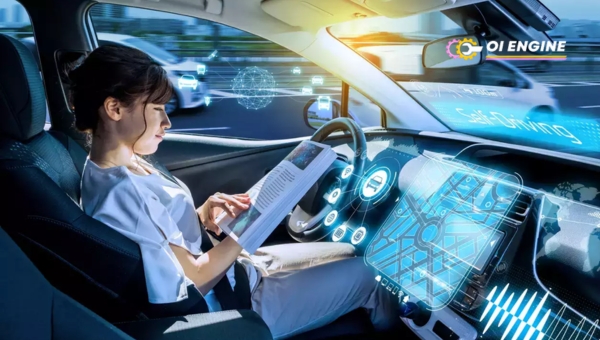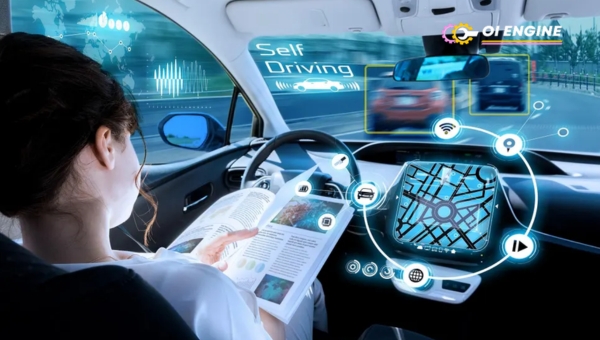The unstoppable march of technological progress has brought us to a fascinating crossroads. “Where are self-driving cars legal?” is a question I pondered.
With the rapid advancements in Artificial Intelligence (AI), autonomous vehicles aren’t some distant sci-fi dream anymore, they’re cruising right here among us.
But with this technology still in its growth stages, it raises important legal and regulatory questions that demand our attention.
In the USA, several states have opened up their roads for these futuristic vehicles to some extent. States such as California, Arizona, Colorado, Florida, and even Washington D.C., allow self-driving cars under specific conditions and regulations.
Where are Self-Driving Cars Legal?
Since their introduction, several states have embraced self-driving cars with open arms. As of today, 27 states have given the green light for these modern marvels to operate freely on their roads.
From sunny California to traditional Mississippi – set to allow autonomous vehicles in March 2023 – these locations stand at the forefront of technological transformation.
However, not all states are alike in their acceptance. Some only permit driverless trucks for commercial purposes while ensuring human drivers continue piloting passenger vehicles.
Understanding which states support what kind of autonomous operations is crucial when navigating this landscape fraught with fine print.
Each state that has legalized self-driving cars has imposed its own set of restrictions and requirements:
- Human Driver Requirement: Some states require a human driver to be present behind the wheel during vehicle operation as a fallback option.
- Type Restrictions: There are six states where only driverless commercial trucks have been legalized, not passenger vehicles.
- Time-Limited Trial Phases: Certain regions have permitted trials for specific periods before making a final decision on legalization.
- Limited Operational Design Domain (ODD): Vehicles might be limited by geography (where they can travel) or other constraints such as weather conditions.
Restrictions Imposed
With this peppering of regulation variations across each state’s rule book, it becomes clear why understanding how each region interacts with these modern machines is critical if one plans to tap into this burgeoning sector unimpededly.
Also Useful: Revamp Your Space With Expert Repair Curtainside Services
Autonomy Spectrum and Legality
Today, when I look at the world of autonomous vehicles, it seems like we’re diving head-first into an ocean of innovation!

But before we take that leap, let’s break down what exactly ‘autonomy’ means in the context of self-driving cars.
Defining Autonomy Spectrum
You might be wondering, what is this ‘autonomy spectrum’? Well, it’s not as complicated as it sounds. The word ‘autonomy’ here refers to how much control a vehicle has over its actions. In simple words, how much can a car do without human help? This varies greatly from car to car.
“SAE International“, an organization known for setting automotive standards worldwide, has defined six levels of vehicular autonomy.
We start with Level 0 where a human driver does everything – accelerating, steering, you name it! Sounds pretty familiar right? However, as we climb up this ladder towards Level 5, we find cars that can handle everything on their own under all conditions – now that’s what I call cool technology!
Between these two extremes are Levels 1-4 which signify different degrees of smartness in cars; some might need human intervention in certain situations while some could handle most tasks solo.
Variations in the legality of autonomy
Now you know about the autonomy spectrum but wonder “Where are self-driving cars legal?” The answer isn’t as straightforward as you might like because legality changes with varying levels of vehicle autonomy. Let me explain:
- Low-level autonomy (Levels 0-2): These aren’t very far from our regular manually driven cars except for some snazzy features like adaptive cruise control or lane guidance system so they’re considered legal just about everywhere.
- Medium-level autonomy (Levels 3): Now here’s where things get interesting! Cars at this stage can handle themselves under certain conditions but might just nudge you for help sometimes. While some states like Arizona and Florida have given the green light to such vehicles, others might require a permit or special testing.
- High-level autonomy (Levels 4-5): Alright, these are the big guns of self-driving technology that are setting benchmarks for an autonomous future! As you can guess, the legalities around them are more complicated. For instance, although California allows testing without a human driver, Pennsylvania limits it only to certain areas.
So as we see, what seems a fun technological advancement is entangled in a complex web of laws gripping it at every level of its evolution!
Be it about where are self-driving cars legal or restrictions on them, we’re still ironing out the creases on this front.
The Role of Human Drivers in Autonomous Vehicles
Even as we edge closer to the possibility of a world dominated by autonomous vehicles, there is still an essential role that human drivers have to play.
As paradoxical as it may seem, with the rise of self-driving cars, the importance of attentive human drivers has not diminished but rather gained remarkable attention.
Why do human drivers need to be attentive to autonomous vehicles?
It’s easy to ask “Why should I stay alert if my car can drive itself?” Here’s why:
- Safety Comes First: Self-driving cars are designed with a multitude of sensors and algorithms aimed at ensuring safety. However, these machines are not infallible, and unexpected situations or errors could arise. In such cases, a vigilant human driver can quickly intervene and control the situation.
- Technology is Still Evolving: While self-driving technologies have come far in their development, they’re not yet perfect. Current self-driving systems operate at what’s categorized as autonomy level 2 by SAE International. This means they require constant human attention and involvement despite having automated features that assist in driving.
- Legal Requirements: Some states that have legalized autonomous vehicles insist that a licensed driver must always be behind the wheel ready to take over control if necessary.
In today’s world where artificial intelligence (AI) has seamlessly taken root, staying attentive while in an autonomous vehicle doesn’t mean doubting technology’s sophistication or capability.
Instead, responsibly observing traffic rules while being ready for sudden interferences is serving our collective goal – Safety first!
Also Related: Your Lawyer Is Dragging His Feet
Insurance Requirements for Self-Driving Cars
Running a self-driving car isn’t just about cutting-edge technology, it also comes with unique insurance requirements.

Depending on the state you are in, as an owner of an autonomous vehicle, you may have to fulfill certain obligations set out by the law and insurance companies.
Through analyzing these regulations, we also get a glimpse into how self-driving cars impact the overall insurance sector.
Insurance Needs for Autonomous Vehicles
In terms of insurance needs, different states have set different benchmarks for autonomous cars:
- In states like California, if you will let run your autonomous vehicle around freely without any human intervention, then it’s compulsory to have an insurance policy with coverage of $5 million. No less than this is acceptable.
- There isn’t a set standard for all other states though. They all come with their own unique rules and regulations which their citizens are expected to abide by.
- Regardless of whichever state you may be in though, having some kind of insurance is mandatory no matter what type or level of the autonomous vehicle you possess.
These diverse rules specific to each state indicate one thing clearly – every state has its way of perceiving and managing the challenges brought up by autonomous vehicles when it comes to insurance.
As such, familiarizing yourself with these requirements before buying a self-driving car can prove to be beneficial in the long run.
Impact on Insurance Sector
The emergence and consistent growth of self-driving cars have undeniably made waves within the automobile industry but we cannot ignore its profound impact on another major segment – The Insurance sector:
- One possible effect that cannot be overlooked is that traditional insurance companies might see a drop in revenues as fewer accidents are anticipated in the future due to advanced AI-driven technology embedded inside these vehicles.
- Several top-notch car manufacturers such as Tesla already offer their built-in insurance thus amplifying competition within this sector.
- Considering rapid advancements in technology, the insurance sector will have to adapt quickly and modify its existing policies. While drafting these policies they’ll also need to account for the varying levels of autonomy as per SAE International’s defined levels, ranging from Level 0 to 5.
All these aspects depict a clear shift taking place within the insurance market. This shift, caused by self-driving cars is triggering the need for adaptation and innovation within the industry.
Also Read: 8 Top Rated Non-Trucking Liability Insurance Providers
What is platooning?
When I first heard of the term ‘platooning’ about self-driving vehicles, I must admit, it puzzled me a bit. But soon I found that platooning is a system where several trucks drive very close to each other in a group or ‘platoon.’
The idea is that the first truck leads, with subsequent trucks autonomously following behind. By doing this, they create a slipstream or kind of “bubble” that allows them to save fuel by reducing air drag. It’s fascinating how technology can make such seemingly counter-intuitive practices possible!
But technology alone isn’t sufficient – safety considerations must be paramount in these scenarios. Suppose you have several huge trucks barrelling down a highway close together at high speeds – each vehicle must know exactly what its brethren are up to in order not to cause a catastrophe!
This is where autonomous technology comes into play; each truck talks to the others electronically and instantaneously responds if one slows down or changes direction.
Legality Around Platooning Trucks
Naturally, with this kind of technology-driven evolution on our roads comes substantial legal debate over suitability and safety terms. The laws around platooning vary quite widely among states:
- For starters, several states have already embraced this new way forward for freight transport by enacting specific laws allowing commercial truck platoons.
- However, it’s worth noting that some states still necessitate certain requirements before permitting platoon driving on their highways – mainly revolving around safety norms.
- For example, Mississippi recently passed legislation making autonomous vehicles (which includes platoon trucks) legal on state roads from March 2023 onwards.
- Equally significantly, in some states, laws have been enacted to specifically protect and regulate platooning. These laws focus on allowing trucks to follow each other closely to improve fuel efficiency, a key concern in today’s climate-aware world.
There’s no doubt that the legal intricacies around platooning are complex and varied; however, as advances in technology continue, the corresponding legislation is sure to evolve in parallel.
Federal Laws Governing Self-Driving Cars
Navigating the legal landscape of self-driving cars is no easy task, given that each state has its own rules and regulations.

But this is where some believe federal laws should step in to streamline the process and set a consistent playing field across all states.
Need for Uniform Federal Laws?
Some people believe that federal laws are necessary for managing autonomous vehicles, and they have several reasons to back up their opinion.
- A piecemeal approach: Current regulations for self-driving cars differ from one state to another, complicating matters for companies operating across these states. A uniform law could help prevent confusion and provide coherent instructions that everyone could follow.
- Promoting innovation: With a single prevailing law throughout the country, businesses involved with autonomous vehicles would have an easier time planning their operations without having to adapt to different rules in different locations.
- Prioritizing safety: The past has shown us how vital it is for comprehensive regulations to be in place when it comes to new technologies like autonomous driving systems. Given some crashes involving these systems reported by the National Highway Transportation Safety Administration over the last year, clear federal laws could potentially guide us toward safer usage of such technology nationwide.
Current Status – Federal vs State Laws
Currently, the legal landscape for self-driving cars in the U.S. is a bit chaotic, with state laws playing a significant role and federal ones not contributing much.
- Variety in State Laws: As of now, over half of U.S. states have passed laws to allow autonomous vehicles on their roads; however, they differ significantly from one another. Some states require the presence of a human driver to take control when needed while others permit entirely driverless vehicles on their roads. These mixed regulations can create confusion making it harder for companies building these cars.
- Limited Federal Involvement: At this stage, there isn’t any comprehensive federal law that regulates self-driving cars across all states – each state sets its own rules and policies regarding these vehicles.
- Future Prospects: The introduction of uniform federal laws governing cryptocurrency could provide clearer guidelines for manufacturers, drivers, and insurance companies alike– potentially paving the way for greater acceptance and utilization of autonomous technology throughout society as a whole.
This fragmented approach can undoubtedly cause problems when businesses need to comply with different sets of rules as they try operating their autonomous fleets in different states across the country.
Advocates believe that integrating more comprehensive federal legislation into this arena could help ensure consistency while also fostering innovation and growth in this promising sector.
Also Check: Is Accounts Receivable Considered An Asset?
FAQs
Are self-driving cars legal everywhere?
No, self-driving cars are not legal everywhere. In the U.S., since 2017, only 27 states have enacted laws allowing driverless vehicles to operate.
Are driverless cars safe?
While driverless cars aim to increase road safety by reducing human error, there have been incidents involving automated driving systems that resulted in injury or death. Hence, safety continues to be a matter of investigation and improvement.
What is level 4 autonomous driving?
Level 4 autonomous driving refers to a high level of automation where the vehicle can handle all aspects of driving in most conditions without human intervention. Seven states allow these vehicles, provided they meet safety standards.
Do driverless taxis exist?
Yes. Several tech firms are testing out self-driving taxis on public roads today under specific conditions and locations including Uber’s pilot program in San Francisco and Waymo’s testing in Phoenix.
Which country has driverless cars?
Several countries are at various stages of permitting and operating self-driving vehicles including the U.S., China, Canada, and some European nations such as Germany and Sweden.
Conclusion
Self-driving cars are driving a transformative wave in the transport industry. Although some states have eagerly embraced this technological marvel, they are dealing with various concerns surrounding labor disruptions, safety risks, and insurance complexities.
The lack of uniform federal laws has led to a piecemeal approach to legislation which could potentially impede the progress of these autonomous vehicles.
As we ride further into the future of autonomy, regulatory frameworks need to grow in tandem with technology. Patience and smart policymaking will be crucial in shaping a future where roads are ruled by robots.
